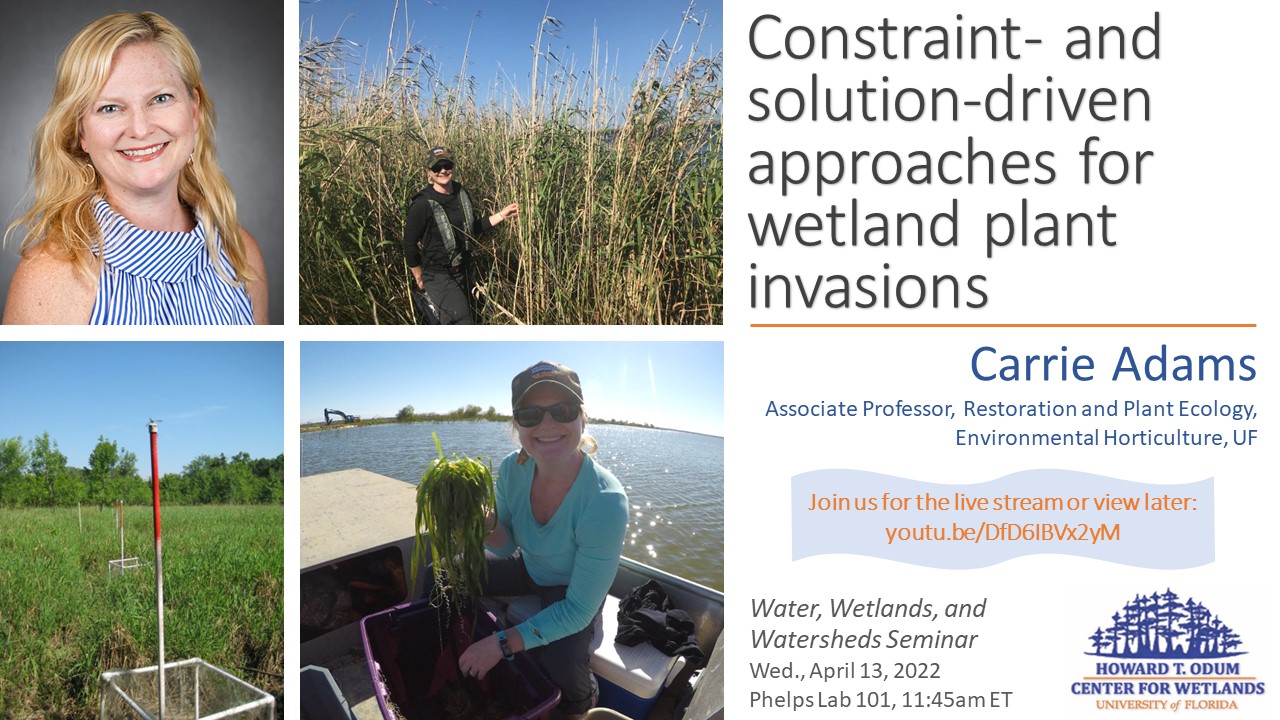Constraint- and solution-driven approaches for wetland plant invasions
Carrie Adams, Associate Professor, Restoration and Plant Ecology, Environmental Horticulture, UF
Join us for the live stream April 13, 11:45am EST: youtu.be/DfD6IBVx2yM
(Please visit our youtube channel main page for the stream if there are any issues with the direct link.)
ABSTRACT
Given the societal significance of wetlands and the disproportionately large amount of time and money spent controlling invaders in remaining wetlands, a fundamental shift must occur in how we approach restoration of plant-invaded wetlands. The need for more research is often used as an excuse for a lack of progress in invader management but, in fact, constraints to invader management are spread across the science, management, and stakeholder engagement domains. At their intersection are “implementation gap” constraints where the monumental efforts required to bridge the gap among scientists, managers, and community stakeholders are often unassigned, unrewarded, and underestimated. Here we synthesize and present a portfolio of broad structured approaches and specific actions that can be used to advance restoration of plant-invaded wetlands in a diversity of contexts immediately and over the long-term, linking these solutions to the constraints they best address. These solutions can be used by individual managers to chart a path forward when they are daunted by potentially needing to pivot from more familiar management actions to increase efficiency and efficacy in attaining restoration goals. In more complex collaborations with multiple actors, the shared vocabulary presented here for considering and selecting the most appropriate solution will be essential. Of course, every management context is unique (i.e., different constraints are at play) so we advocate that involved parties consider a range of potential solutions, rather than either assuming any single solution to be universally optimal or relying on a solution simply because it is familiar and feasible. Moving rapidly to optimally effective invasive plant management in wetlands may not be realistic, but making steady, incremental progress by implementing appropriate solutions based on clearly identified constraints will be critical to eventually attaining wetland restoration goals.
Bio
Dr. Carrie Reinhardt Adams is an Associate Professor at the University of Florida. Her BS (Environmental Resources Management) and MS (Ecology) are from Pennsylvania State University, and her PhD is from University of Minnesota (Water Resources Science). Her research concerns ecological restoration wetland plant communities and scaling-up experimental manipulations to applications for natural resource management. She teaches graduate and undergraduate courses on restoration ecology and plant materials for conservation and restoration. She is on the Editorial Board of the journal Ecological Restoration and is currently serving on the as past-chair of the Women in Wetlands Section of the Society of Wetland Scientists.
POSTCARD

